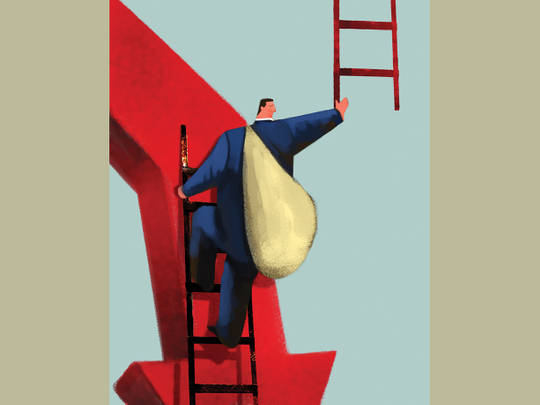
The sharp reduction in oil prices has led to continuing concerns about the health of the global economy, and, more specifically, that of the Middle East. After a decade of high prices, adjusting to the new reality has led to budget cuts and layoffs, as lower liquidity has led to after-effects in other parts of the economy.
The job cuts that have been heavily publicised have added to the sombre mood on the future outlook of the economy. It is these effects that need to be examined if a clearer understanding is to be gleaned from the “noise” surrounding the market place.
As far as the global economy is concerned, the fall in oil prices has been tantamount to a tax cut that acts as a stimulus. In effect, there has been a transfer of wealth from the highly leveraged oil and gas sector, particularly the shale industry, to the relatively debt-light consumer. And it is this transfer of wealth that will likely spark an increase in consumer spending.
This is similar to the situation in 1998, when oil prices fell by more than 50 per cent after the Asian Financial Crisis. Then too there were concerns about the health of the global economy; but after some anxiety, growth surged as consumer spending increased dramatically. Then, as well as now, there was some ricochet effect on the banks, as a fall in oil prices led to a number of companies going out of business as they could not service their debts.
These led to bad debts, and along with the impact of the financial crisis, led to layoffs that then were transmitted along other parts of the economy. In the Middle East, the sharp fall in liquidity led to a slowdown in government spending, and as this transmitted itself to the broader economy led to defaults, particularly in the SME sector, and subsequent layoffs added to uncertainty over future growth.
The comparisons reveal an eerily similar environment to what is being experienced now. The Asian Financial Crisis has been replaced by concerns about China. But, broadly speaking, the scenario that has unfolded thus far has been virtually identical to what transpired nearly two decades earlier.
From the angst in the capital markets to the drying up of liquidity and the reduction in government spending (for the most part), there appears to be a redux of the situation in 1998. However, behind this surface level analysis, there have been structural changes that have not yet been made visible in the data.
Oil prices for the consumer have been liberalised throughout the Middle East as subsidies have been slashed, with similar moves in liberalising electricity and water prices on the anvil. The region has ample reserves that are being drawn down upon, and banks, for the most part, are more highly capitalised than they were in 1998 or even for that matter, in 2008.
The flight to liquidity in the form of asset sales appears to be overdone, especially since liquidity carries with it a “negative carry” in the form of lost income and capital appreciation potential. This is especially with regards to valuation and how far asset prices have actually fallen.
It is the structural reality on the ground that appears to have been most ignored. Dubai continues to increase budgetary expenditure, with large amounts being spent on infrastructure, education and health. This continued allocation of resources may well be different to the effects of quantitative easing that took place in the US where the chief beneficiary of monetary policy was to artificially boost the value of asset prices.
But the emphasis on a structurally sound expansionary fiscal policy has the effect of boosting productivity and efficiency in the broader economy and has the outcome of a return distribution that is both balanced and more equal, as is evident from history. It is this policy that Dubai has adopted, and with a more liberal economic framework, set the stage for sustained economic growth that will undoubtedly be reflected in the earnings and, hence the value of assets, in coming years.
The reduction in oil prices has sparked a “liquidity premium” with the move to cash. This premium shifts depending on the economic cycle and the extent of this premium will dictate the subsequent trajectory of economic growth.
What Dubai is showing is that these liquidity concerns appear to be exaggerated, and with its prudent fiscal policy has charted a road forward that takes cognisance of its economic potential. It is this prudence that will show up in the data, as it did in 1998 when after a period of turbulence, economic growth surged.
To be sure, the level of anxiety currently being expressed has some merit, but it is the policy response that has already in motion that suggests that fears appear to be overdone.
The writer is Managing Director of Global Capital Partners.












